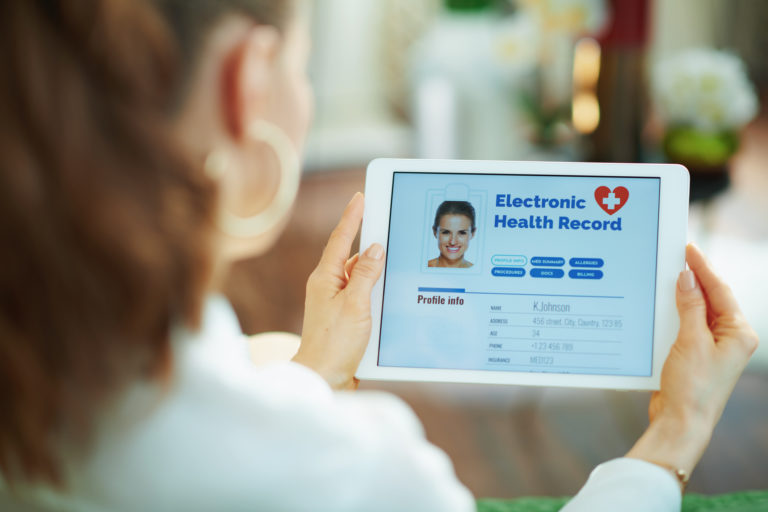5 Patient Experience Tips That Will Redefine Your Practice
The patient experience encapsulates more than just a visit to the doctor’s office.
It starts before someone has become a patient and continues on throughout his or her time spent at your practice, however long it is.
It’s the overall experience that dictates whether or not patients view your practice positively, how engaged they are with their own healthcare and whether or not they recommend your practice to their friends and family.
Studies show that 57% of patients say they want to be more engaged with their healthcare providers.
Roughly the same percentage of providers say they want to improve their engagement with patients, and nearly 70% say they have seen positive changes in engagement when they’ve put in the effort.
Once a patient has a positive experience with your practice, they’re more likely to experience what’s known as “the halo effect.
The halo effect happens when one positive experience leads to more positive experiences and an overall favorable view, even if you don’t do everything perfectly.
The good news is that it doesn’t take much to create a halo effect, but it does take participation from staff members to ensure that a positive experience happens.
Here are 5 ways that practitioners can ensure their patients have positive experiences before, during and after their time spent at the clinic.

1. Show Physical Expressions of Care and Concern
Indifference can be a major deterrent to a positive patient experience.
Unfortunately, indifference is somewhat notorious with healthcare: doctors avoiding eye contact, reception staff speaking harshly, patients ignored by nurses or made to wait unnecessarily long for treatment.
Patients can pick up on these subtle (or sometimes not so subtle) clues during their visit.
Tone of voice, facial expressions and other signs of indifference can cause anxiety and impact the level of care provided.
Healthcare practices, hospitals and clinics can be busy places. In the hustle, it can be easy for staff to become overwhelmed and distracted.
After all, they’re only human, too.
This can lead to harsh speaking voices or general dismissal of certain symptoms. While in some cases this can be a matter of frustration for patients, in some cases it can be deadly.
One John Hopkins study found that roughly 250,000 Americans die every year from medical errors and overlooked symptoms. In some cases, even small symptoms that may not seem important can end up being life threatening when not properly monitored.
Having office staff that is unresponsive can lead to medical calamity if not careful.
But staff should also be trained in how to respond to patients in both crisis and non-crisis situations.
Patients can come into the clinic with questions, concerns or frustrations that are not the results of any actions the staff has performed. Sometimes a doctor’s visit is enough to induce anxiety in even the calmest of individuals.
It’s important for staff to be trained how to listen to concerns and understand the significance of symptoms and complaints.
Should incidences arise where there are complaints or concerns, staff should also be ready to respond appropriately.
This includes practicing the signs of active listening, such as:
- Maintaining eye contact
- Smiling or showing empathy
- Keeping body language open (no folder or crossed arms, etc.)
- Asking questions
- Clarifying statements
Focusing on the person in front of you can make a difference in how respected and valued they feel, which can impact the level of care received, and ultimately how the practice is viewed and talked about.
It’s important to train employees how to handle difficult situations before they happen. Even if handling the concern simply means saying, “I will find someone who can help you right now.”
Staff should also know how to say, “Sorry.”
Sometimes poor patient experience can result from undertraining or poor systems in the clinic itself – issues that must also be addressed.
As the founder of the Ritz-Carlton is fond of saying, “If a mistake happens once it may be fault of the employee. If it happens twice, it is most likely the fault of the system.”
Focusing on creating systems and training programs that encourage positive and mindful patient interactions can go a long way to improving the overall patient experience and helping patients feel relaxed before, during and after they receive care.
2. Put Yourself in the Patient’s Shoes
Though practitioners and office staff only encounter patients while they’re inside the clinic (most of the time, anyway), they don’t always experience their services the way the patient does.
That’s because the patient experience truly starts before someone comes into the office.
It happens when they go on your website, where they browse for information and fill out essential forms. It happens with a phone call or online scheduling software to book an appointment.
It happens when they park in your parking lot and walk into your office.
It happens when they leave your office, or pick up prescriptions, or reschedule their next visit.
The patient experience encompasses tasks that office staff never have to deal with, which can make it difficult for healthcare professionals to truly put themselves in the patient’s shoes.
Everyone who is a part of the clinic should make it a priority to understand how patients interact with every component of the clinic.
You should know how your website works, how to navigate it and book an appointment, for example.
You should know whether or not the handicap parking spaces are close enough to entrance and how easy it is to get to through the front door on crutches.
If possible, doctors and office staff should park where the patients park so they understand the limitations of the parking lot, especially for those who may have difficulties getting into the building.
Take a tour of your hospital or practice with someone who has never been there before and let them show you areas of the patient experience you may have overlooked in your familiarity.
Consider other elements such as:
- How comfortable the chairs are in your waiting room
- How easy it is to get coffee or water or other amenities while waiting
- How clean the bathrooms are and their ease of accessibility
- How easy it is to see the front desk staff if you’re short or tall
- How accessible call buttons or other emergency resources are
Help doctors and staff understand the ups and downs of the patient experience so they know how to improve someone’s day, even if it’s in a small way or with a slight gesture of kindness.

3. Improve Systems With Better Technology
Technology is another key component to the patient experience that has taken up more importance in recent years.
There are plenty of ways to introduce new technology in your clinic, like including patient intake forms on your website or using in-office technology like tablets or mobile apps for better service.
Technology can also play a pivotal role in the waiting room experience. Some patients may find it comforting to select music or watch television while they wait.
But even if you can’t offer technology in patient-controlled situations, it’s still important for providers to give patients more access to technology that can help them manage their healthcare.
According to Capterra, almost 40% of patients say they have “never heard of a patient portal before” and 23% say they “know it is available, but don’t use it.”
Seeing as how technology provides many benefits to patients, from reducing wait times to improving decision making, it’s essential that providers make use of technology like patient portals, online forms and Electronic Healthcare Records (EHR) at the very least.
In one whitepaper from The Beryl Institute, healthcare leaders explored a few of the ways that technology plays into the patient experience. What they found was six ideas that are “central and relevant to positively impacting experience.”
Those six ideas are:
1. Patients should be at the center of technology discussions. Healthcare leaders must view patients not just as recipients of technological innovations, but also as active partners in helping shape what those innovations look and feel like.
2.Feedback from care teams is essential. It’s important to include and acknowledge the perspectives of those involved in care delivery to ensure they can do their work effectively.
3.Leaders must embrace the changing nature and relationship structure of healthcare. As individuals have broader access to information, connectivity and mobile resources, the ways they make choices will change. The shift in care delivery should change how healthcare leaders think about patient experience as a whole.
4.Patient experience is the sum of numerous interactions, including those with technology. Decisions made about technology should not be made in a vacuum, but with intention and thoughtfulness that considers the whole experience.
5.Adding technology just to seem cutting-edge is a bad idea. Despite what some healthcare leaders are told, implementing new technology just to have it is a disastrous idea. Technology must be integral to the overall patient experience.
6.Ensuring that healthcare technologies can communicate is crucial. Patient experience and technology are inseparable, so technology must be able to talk, share, collaborate and drive collective conclusions effectively.
Björn Stansvik, Founder/CEO, MentorMate believes that technology in the healthcare world will need to be more data focused than it already is.
“We’ve had many of the same ideas for a decade,” he says, “but I think 2017 will be the year data networks come together to create more of a complete patient picture, the humans and machines will start linking in meaningful clusters through the opening of APIs. The world is finally ready to realize the promise we’ve been talking about.”
This includes integrating data-based technology that gives the patient more access and control over their healthcare choices.
According to recent research, 67% of all providers report using an EHR, and over 95% of hospitals eligible for the Medicare and Medicaid EHR Incentive Program have started using them.
4. Create a Comfortable Office Space
The physical surroundings of your office space also play an important role in patient experience.
You may not always have control over how your practice’s environment looks, but you should do your best to make sure the office environment is aesthetically calming and welcoming.
A well-designed waiting room experience can reduce patient anxiety and improve perceptions about the quality of care someone might receive from your practice.
One study conducted at outpatient clinics found a direct correlation between the waiting room aesthetics and opinions about the level of care a patient would receive.
Even if you can’t redesign your entire waiting room, you can still do your best to keep things clean, use neutral colors (with brighter colors for important signs or guides) and reducing office clutter.

The important thing to remember when it comes to the workspace is to keep people calm and comfortable.
If possible, invest in good seating in your waiting room area, as that’s where most patients will spend their time.
Use artwork to brighten up drab areas of the waiting room and around the office space, but keep the patient rooms clean with neutral colors.
Whites, blues and light grays can all communicate health and wellness and are great wall colors for keeping patient rooms looking clean and comfortable.
You should also include activities for children or other ways that patients can stay active in the waiting room, such as using child-friendly books, (updated) magazines, and other technology to keep people engaged.
The more that patients have to do in the waiting room, the less time they have to worry about their impending visit.
You can also do cheap updates to your office space to make things more friendly, such as offering charging stations for phones or playing calming music.
If you don’t have the ability to offer all of the fancy amenities as other practices, don’t fret. While patients certainly appreciate the niceties, they’re not necessary to give patients a positive experience.
In fact, improving on other things from this list, like active listening, showing empathy, and giving patients access to important healthcare information, can beat out a fancy office space.
5. Promote Healthcare Outside of the Office
As mentioned before, the patient experience doesn’t stop once someone leaves your practice. Much of the time, it’s the start of a longer relationship.
Out of office patient care is equally as important as in-office care.
Patients may have follow up questions after their initial visit, or if they received certain diagnoses, for instance.
They may be receiving new or changed medication, in which they will need to monitor side effects.
They may not have received all the answers they needed about their health, or might be looking for solutions to continue to improve their health so they don’t have to frequent the doctor quite as often.
Healthcare practices and professionals should be an ongoing resource to address needs and answer questions.
Since doctors try to dissuade patients from contacting them after hours (for good reason), the clinic should provide other ways that patients can still get post-visit care.
Your site could have a live chat feature that allows patients to type in questions and receive automated responses, or even an online symptom checker could help.

Having resources and FAQs available online can help patients when they’re researching their care before and after their initial visit, for example.
Links to post-op videos, articles or other resources can improve engagement.
Having doctor’s notes or prescription information available on their patient portal may also help.
The more opportunities that patients have to interact with your clinic after hours, even if it’s something as simple as visiting your website or engaging with you on social media, can help improve the patient experience after hours, too.
Here are 7 more tips to engage with patients outside of the office.
Final Thoughts
Improving the patient experience takes everyone who is a part of your office, from front desk staff to healthcare leaders and professionals and everyone in between.
Start thinking about the patient experience as something that happens before, during and after someone visits your practice. Listen to what patients have to say about how your clinic works and put yourself in their shoes.
Practice active listening and do what you can to ensure that your office environment is friendly and mindful.
And don’t forget to offer technology and other resources that put patients in control of their own health. Not only will that eliminate some of the burden from your busy staff, but it will also produce the much-desired halo effect for patients.



